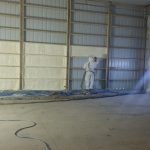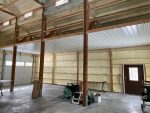Spray Foam Insulation on Interior Surfaces of Metal Panels
Information excerpted from MBCI.com
 When it comes to insulating a building envelope, there are various methods that can be used depending on the building’s purpose and the required level of insulation. However, combining metal roof and wall panels with spray polyurethane foam insulation (SPF) is widely considered one of the most effective ways to achieve secure, strong, and long-lasting insulation. Utilizing this method of insulation offers numerous benefits including the sealing of panel joints, creating a vapor barrier, providing thermal insulation, and producing air barriers.
When it comes to insulating a building envelope, there are various methods that can be used depending on the building’s purpose and the required level of insulation. However, combining metal roof and wall panels with spray polyurethane foam insulation (SPF) is widely considered one of the most effective ways to achieve secure, strong, and long-lasting insulation. Utilizing this method of insulation offers numerous benefits including the sealing of panel joints, creating a vapor barrier, providing thermal insulation, and producing air barriers.
One of the most notable advantages of utilizing SPF insulation is that it can be used to fill spaces in the panel assemblies and function as a key component of an air barrier system, effectively reducing air leakage. However, there are a few design parameters to be mindful of when considering the use of SPF insulation for metal roof or wall panels. The Spray Polyurethane Foam Alliance (SPFA) has conducted research on the installation of SPF on steel panels and has suggested the following best practices for applying SPF to the interior surface of metal panels:
Closed-cell foam is recommended due to its water-resistant capabilities.
SPF is a recognized insulation material to be used below and in contact with through-fastened metal roof assemblies.
The surface of the metal panel being sprayed should be free from moisture, lubricants, dirt, or other contamination.
The technique used to apply the SPF can affect the performance and appearance of the foamed panels.
Using a release fabric membrane between foam and a metal panel in a wall assembly is not recommended due to the potential of creating voids between the SPF and the wall panel.
There is potential for stress-induced deformation (or “oil canning”) on 29 gauge or thinner material. (This can be minimized by following the foam manufacturers’ recommended application technique.)
Always follow national and local code requirements for fire protection. Exposed SPF may require an additional thermal barrier or other means for fire protection.
Consider using an SPF contractor accredited by SPFA’s Professional Certification Program (1) (compliant with ISO 17024) to provide high-quality and safe installation of SPF insulation.
It is important that a certified foam spray technician applies SPF to the required insulation thickness to achieve the optimum insulation density, adhesion, and thickness. The recommended application method when applying the foam is to use the controlled thickness spray technique, commonly known as the “picture frame” technique. SPFA describes this technique as if someone were following through the motion of picture framing, in which the applicator surrounds the interior perimeter of the wall framing stud and allows the foam to rise along the stud. This technique can also help to prevent SPF from getting between girts and architectural metal wall panels which could cause metal deformation.
 The thickness of the initial pass fillet during picture framing should be at least 0.5 inch and should not exceed the maximum pass thickness recommended by the foam manufacturer. The minimum thickness of the initial pass is specified to provide enough material to activate the blowing agent and initiate the cure. After picture framing the perimeter of the area, the applicator fills in the center of the cavity using the maximum thickness recommended by the foam manufacturer. Maximum pass thickness varies by foam formulation and is listed in the technical data for each SPF product. Excessive pass thickness can result in inferior quality due to the increase in foam temperature during curing. For most closed-cell SPF, the maximum pass thickness is 1.5 to 2 inches. It is important for applicators of closed-cell SPF to follow manufacturers’ installation instructions on pass thickness limits and proper cooling times between subsequent passes made if they wish to develop the desired total thickness of the insulation.
The thickness of the initial pass fillet during picture framing should be at least 0.5 inch and should not exceed the maximum pass thickness recommended by the foam manufacturer. The minimum thickness of the initial pass is specified to provide enough material to activate the blowing agent and initiate the cure. After picture framing the perimeter of the area, the applicator fills in the center of the cavity using the maximum thickness recommended by the foam manufacturer. Maximum pass thickness varies by foam formulation and is listed in the technical data for each SPF product. Excessive pass thickness can result in inferior quality due to the increase in foam temperature during curing. For most closed-cell SPF, the maximum pass thickness is 1.5 to 2 inches. It is important for applicators of closed-cell SPF to follow manufacturers’ installation instructions on pass thickness limits and proper cooling times between subsequent passes made if they wish to develop the desired total thickness of the insulation.
Installers are trained to check the substrate surface for moisture, dirt, oils, rust, or other conditions that can interfere with proper foam adhesion. It is also important to clean the surface of these contaminants prior to spraying the insulation. If there is uncertainty surrounding the amount of adhesion needed for a metal surface, this can be determined onsite using a pull-tester in accordance with ASTM (American Society for Testing and Materials) D 4541 (Standard Test Method for Pull-Off Strength of Coatings Using Portable Adhesion Testers).
When the time comes to change an outdated or damaged panel, many SPF contractors use a release material such as building wrap or fabric to allow for a seamless and pain-free swap out. However, it is important to keep in mind that the use of a release material poses the potential of creating air gaps between the back of the SPF foam and the metal panel. These gaps could allow condensation to accumulate between the SPF and the panel and framing members.
Closed-cell Spray Polyurethane Foam is a viable insulation material for the interior surfaces of steel and aluminum metal wall panels. This foam application can be highly nuanced, and there is a possibility of deformation, distortion, or oil canning if the application of the SPF is done poorly






